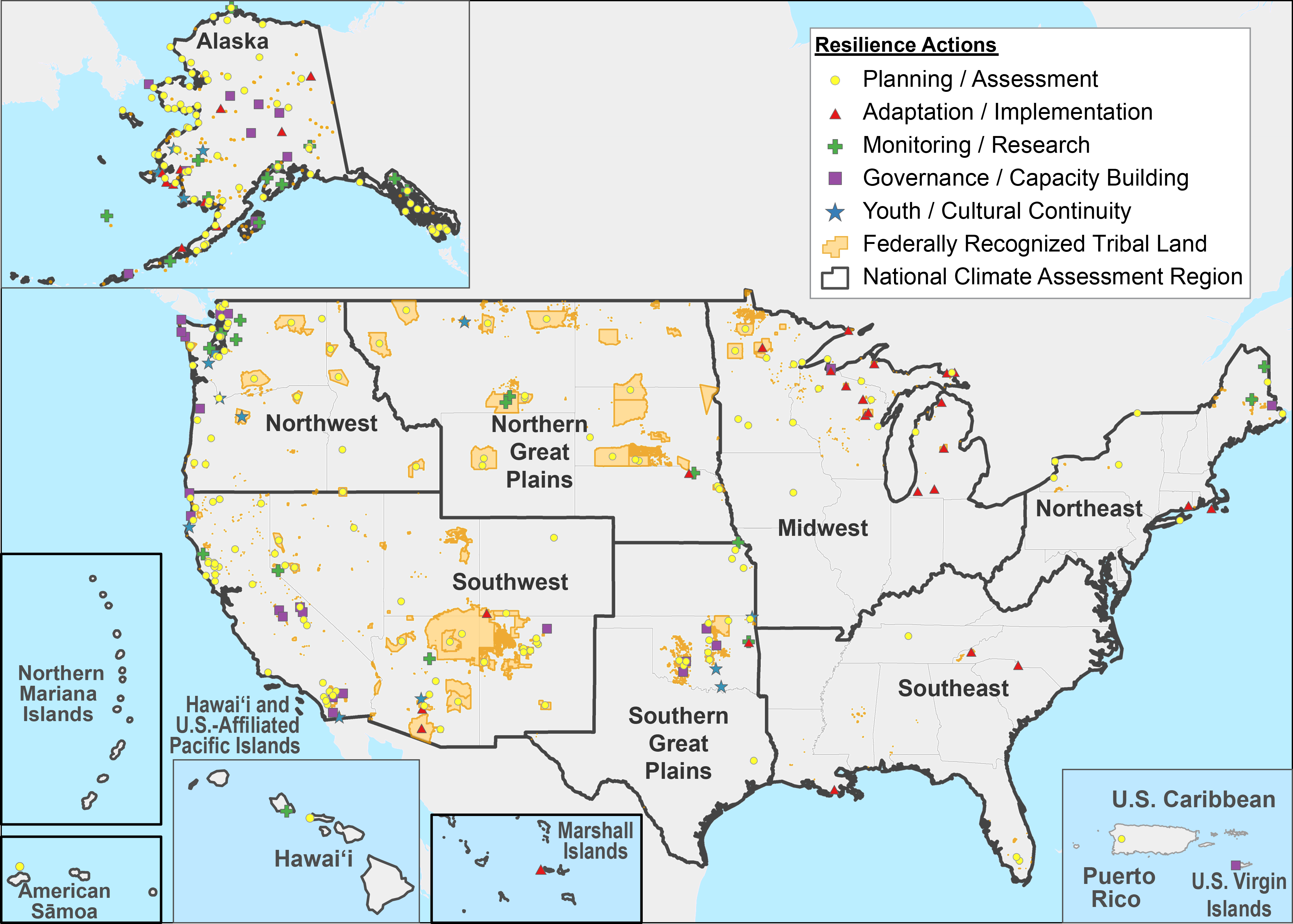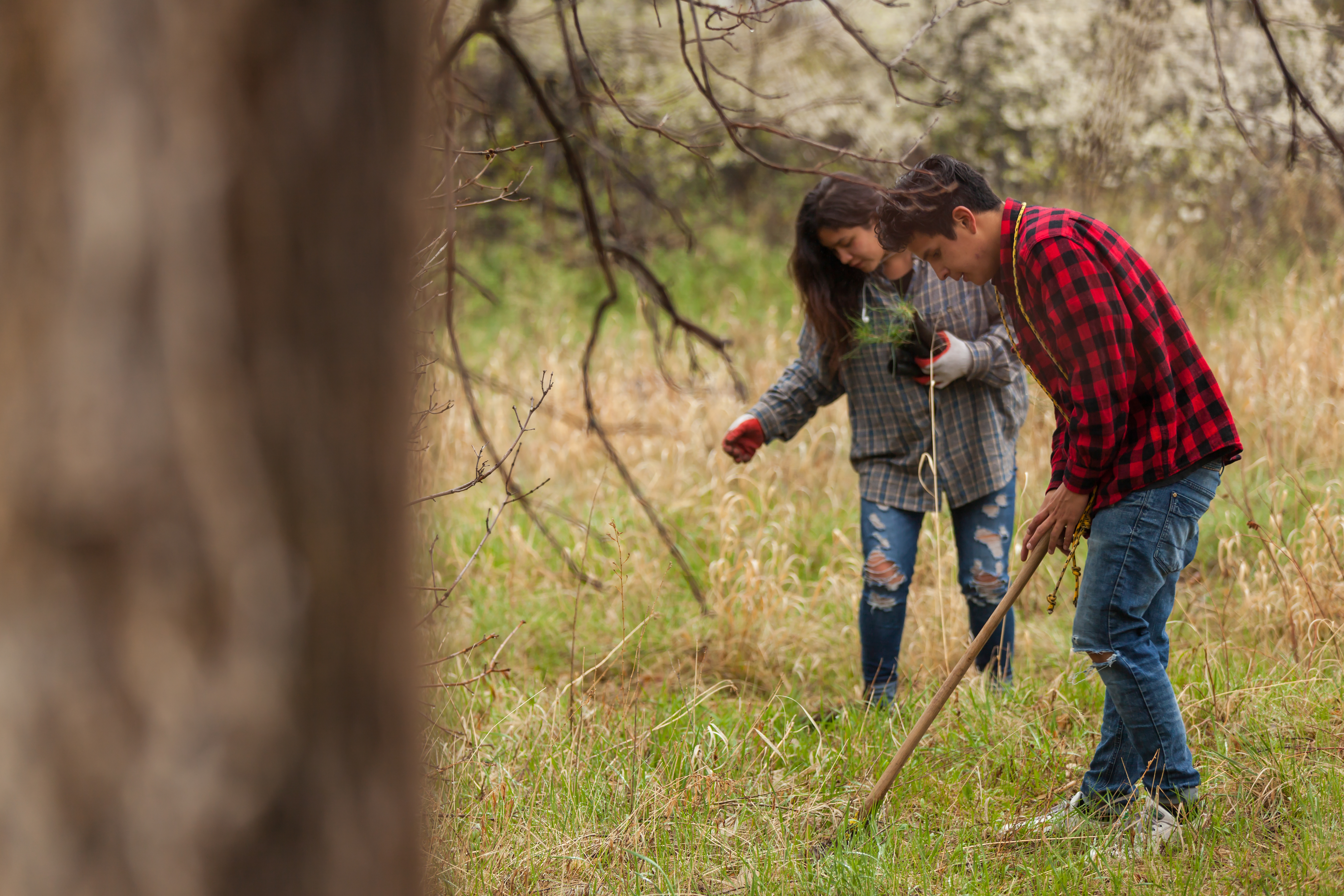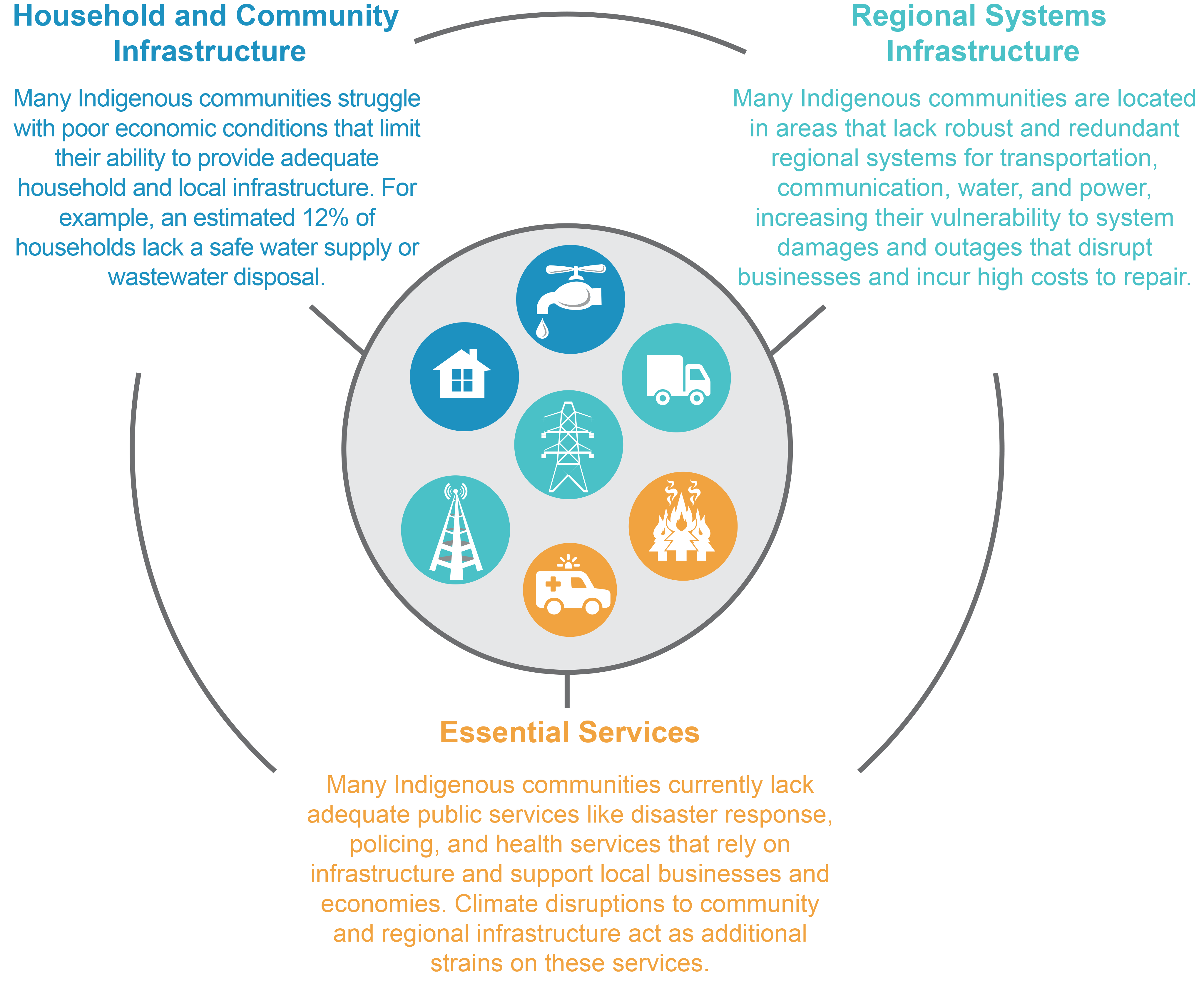The report authors developed this chapter through technical discussions of relevant evidence and expert deliberation via several meetings, teleconferences, and email exchanges between the spring of 2016 and June 2017. The authors considered inputs and comments submitted by the public in response to the U.S. Global Change Research Program’s (USGCRP) Federal Register Notices, as well as public input provided through regional engagement workshops and engagement webinars. The author team also considered comments provided by experts within federal agencies through a formal interagency review process.
Additional efforts to solicit input for the chapter were undertaken in 2016–2017. The Bureau of Indian Affairs (BIA) worked with partners, the College of Menominee Nation, and the Salish Kootenai College to develop and execute an outreach plan for the chapter. This included awarding mini-grants for community meetings in the fall of 2016 and attending and presenting at tribally focused meetings such as the American Indian Higher Education Consortium 2016 Student Conference (March 2016), the Annual National Conference of the Native American Fish and Wildlife Society (May 2016), the National Tribal Forum on Air Quality (May 2016), the workshops of Rising Voices (2016, 2017), the Native Waters on Arid Lands Tribal Summit (November 2017), the BIA Tribal Providers Conference in Alaska (November 2017), and the Tribes & First Nations Summit (December 2017), among others. Additionally, through these tribal partners, the BIA provided 28 travel scholarships to interested tribal partners to attend and comment on the initial draft content of all regional chapters at the USGCRP’s regional engagement workshops. Additional avenues to communicate during these formal open-comment periods included multiple webinars, website notices on the BIA Tribal Resilience Program page, and email notices through BIA and partner email lists. In particular, the BIA solicited comments from multiple tribal partners on the completeness of the online interactive version of the map in Figure 15.1. Chapter authors and collaborators also presented at interactive forums with tribal representatives, such as the National Adaptation Forum (2017), and in various webinars to extend awareness of formal requests for comment opportunities through the USGCRP and partners, such as the Pacific Northwest Tribal Climate Change Network. The feedback and reports from these activities were used to ensure that the Key Messages and supporting text included the most prominent topics and themes.
Key Message 1: Indigenous Livelihoods and Economies at Risk
Climate change threatens Indigenous peoples’ livelihoods and economies, including agriculture, hunting and gathering, fishing, forestry, energy, recreation, and tourism enterprises (very high confidence). Indigenous peoples’ economies rely on, but face institutional barriers to, their self-determined management of water, land, other natural resources, and infrastructure (high confidence) that will be impacted increasingly by changes in climate (likely, high confidence).
Description of evidence base
Multiple studies of Indigenous peoples in the United States provide consistent and high-quality evidence that climate change is both a current and future threat to Indigenous livelihoods and economies. The climate impacts on traditional subsistence economies and hunting and gathering activities have been extensively documented and consistently provide qualitative observational evidence of impacts.4,5,7,22,23,24,25,26,27,28,29,31,32,44 There is also very robust documentation of observed adverse climate change related impacts to Indigenous commercial sector activities in agriculture, fishing, forestry, and energy,22,29,33,36,37,39,40,41,42,43,44,45,46,47,48,49,73,154 as well as recreation, tourism, and gaming.5,50,51,52,53 These sectors form the basis of most Indigenous economies in the United States.
Multiple studies also consistently identify funding constraints as barriers to the economic development of federally and non-federally recognized tribes,21,22 as well as barriers that limit self-determination stemming from historical and ongoing federal oversight of natural resources on tribal trust lands,8,11,17,18 including energy resources.77,78 Multiple qualitative studies provide consistent and high-quality evidence of current vulnerabilities and challenges related to infrastructure and linked systems that support Indigenous economies and livelihoods.19,22,49,73,74,76 Despite these challenges, there is consistent and high-quality evidence supporting the finding that energy development, particularly renewable energy, that is implemented in accordance with Indigenous values holds promise as a source of revenue, employment, economic self-determination, and climate mitigation and adaptation for Indigenous communities.22,79,80
The studies cited above consistently conclude that these impacts on livelihoods and economies will increase under future projections of climate change. However, methods for making these determinations vary, and quantitative or modeling results that are specific to Indigenous peoples in the United States are limited.
Major uncertainties
As with all prospective studies, there is some uncertainty inherent in modeled projections of future changes, including both global climate system models and economic sector models. In addition, none of the cited studies explicitly modeled the effects of climate adaptation actions in the relevant economic sectors and the extent to which such actions may reduce Indigenous vulnerabilities.
The literature currently lacks studies that attempt to quantify and/or monetize climate impacts on Indigenous economies or economic activities. Instead, the studies cited above in the “Description of evidence base” section are qualitative analyses. The chapter references Chapter 29: Mitigation for some quantitative studies about climate impacts to U.S. economic sectors, but these are not specifically about Indigenous economies. Quantitative national studies of climate impacts may have general applicability to Indigenous peoples, but their overall utility in quantifying impacts to Indigenous peoples may be limited, because there is uncertainty regarding the extent to which appropriate extrapolations can be made between Indigenous and non-Indigenous contexts.
Other uncertainties include characterizing future impacts and vulnerabilities in a shifting policy landscape, when vulnerabilities can be either exacerbated or alleviated in part by policy changes, such as the quantification and adjudication of federal reserved water rights and the development of policies that promote or inhibit the development of adaptation and mitigation strategies (for example, the development of water rights for instream flow purposes).19
Description of confidence and likelihood
Given the amount of robust and consistent studies in the literature, the authors have very high confidence that Indigenous peoples’ subsistence and commercial livelihoods and economies, including agriculture, hunting and gathering, fishing, forestry, recreation, tourism, and energy, face current threats from climate impacts to water, land, and other natural resources, as well as infrastructure and related human systems and services. The authors have high confidence in the available evidence indicating that it is likely that future climate change will increase impacts to water, land, other natural resources, and infrastructure that support Indigenous people’s livelihoods and economies. The authors have high confidence that Indigenous peoples’ economies depend on, but face institutional barriers to, their self-determined management of water, land, other natural resources, and infrastructure, stemming from funding constraints and the complexities of federal oversight of trust resources.
Key Message 2: Physical, Mental, and Indigenous Values-Based Health at Risk
Indigenous health is based on interconnected social and ecological systems that are being disrupted by a changing climate (high confidence). As these changes continue, the health of individuals and communities will be uniquely challenged by climate impacts to lands, waters, foods, and other plant and animal species (likely, high confidence). These impacts threaten sites, practices, and relationships with cultural, spiritual, or ceremonial importance that are foundational to Indigenous peoples’ cultural heritages, identities, and physical and mental health (high confidence).
Description of evidence base
Multiple epidemiological studies provide consistent and high-quality evidence that Indigenous peoples face health disparities according to conventional Western science approaches to assessing health risk; in general, Indigenous peoples have disproportionately higher rates of asthma,90 cardiovascular disease,91,92,93,94 Alzheimer’s disease or dementia,95,96 diabetes,97 and obesity.93 There is also robust qualitative evidence that various social determinants of health affect Indigenous health disparities, including historical trauma,88,89 institutional racism, living and working circumstances that increase exposure to health threats, and limited access to healthcare services.87,89 A recent peer-reviewed scientific assessment of health concluded that these health disparities have direct linkages to increased vulnerability to climate change impacts from changes in the pollen season and allergenicity, air quality, and extreme weather events.98
Additionally, a number of qualitative studies consistently find that Indigenous health, adaptive capacity, and health disparities/environmental justice issues typically do not capture many of the key elements of health and resilience that are important to Indigenous populations, which include concepts related to community connection, natural resources security, cultural use, education and knowledge, self-determination, and autonomy.81,82,83,84,85,86 Available qualitative evidence consistently identifies Indigenous peoples as having a unique and interconnected relationship with the natural environment and wildlife that is integral to their place-based social, cultural, and spiritual identity; intangible cultural heritage (traditions or living expressions transmitted and inherited through generations); and subsistence practices and livelihoods that foster intra- and intergenerational knowledge sharing and relationships.29,44,61,81,82,86,87,99,100,101,102,103,105 Climate impacts to lands, waters, foods, and other plant and animal species undermine these relationships, affect place-based cultural heritages and identities (including through damage to cultural heritage sites), may worsen historical trauma still experienced by many Indigenous peoples, and ultimately result in adverse mental health impacts.86,101,102,106 There is robust documentation of observed adverse climate change related impacts on culture and food security,44,61,99,103 physical health,98 and mental health.71,101,102,104,107
The studies consistently conclude that these adverse impacts to culture,61,155 food security,61,99 and overall human health98,99,101,102 will continue under future projections of climate change, though methods for making these determinations vary, and there are limited quantitative or modeling results that are specific to Indigenous peoples in the United States.
There is consistent evidence from behavioral and public health research showing that responses to extreme heat serve as examples of climate change adaptation.108,109,110,111 There are also multiple examples of tribal health vulnerability assessments that acknowledge the role of traditional subsistence species, or First Foods, as an essential aspect of health and tribal resilience.60,112 One example from the Republic of the Marshall Islands illustrates a community-led planning process that incorporates traditional knowledge, facilitates local self-determination, and supports climate adaptation, natural resource management, and community health goals.85
Major uncertainties
The literature currently lacks national-scale studies that quantify and/or monetize climate impacts on Indigenous health, either through traditional Western science health metrics or Indigenous values-based metrics and indicators of health. There are quantitative studies of specific health-relevant topics, such as climate impacts to air quality (Ch. 13: Air Quality) or extreme heat (Ch. 29: Mitigation), but health impact models have not to date been used to model Indigenous population-specific climate impacts. Quantitative national studies of climate impacts may have general applicability to Indigenous peoples, but their overall utility in quantifying impacts to Indigenous peoples may be limited, because there is uncertainty regarding the extent to which appropriate extrapolations can be made between Indigenous and non-Indigenous contexts. In addition, none of the studies explicitly modeled the effects of climate adaptation actions and the extent to which such actions may reduce Indigenous vulnerabilities or projected future impacts.
Other uncertainties include characterizing future impacts and vulnerabilities in a shifting policy landscape, in which vulnerabilities can be either exacerbated or alleviated in part by policy or programmatic changes, such as a recognition of the non-physiological aspects of Indigenous health.
Description of confidence and likelihood
Based on available evidence, the authors have high confidence that Indigenous health is based on interconnected social and ecological systems that are being disrupted by a changing climate. The authors have high confidence in the available evidence indicating that it is likely that future climate change will increase impacts to lands, waters, foods, and other plant and animal species and that Indigenous health will be uniquely challenged by these impacts. The authors have high confidence, based on the quality of available evidence, that the lands, waters, foods, and other natural resources and species are foundational to Indigenous peoples’ cultural heritages, identities, and physical and mental health due to their essential role in maintaining Indigenous peoples’ sites, practices, and relationships with cultural, spiritual, or ceremonial importance.
Key Message 3: Adaptation, Disaster Management, Displacement, and Community-Led Relocations
Many Indigenous peoples have been proactively identifying and addressing climate impacts; however, institutional barriers exist in the United States that severely limit their adaptive capacities (very high confidence). These barriers include limited access to traditional territory and resources and the limitations of existing policies, programs, and funding mechanisms in accounting for the unique conditions of Indigenous communities. Successful adaptation in Indigenous contexts relies on use of Indigenous knowledge, resilient and robust social systems and protocols, a commitment to principles of self-determination, and proactive efforts on the part of federal, state, and local governments to alleviate institutional barriers (high confidence).
Description of evidence base
There is robust documentation of ongoing Indigenous adaptation to climate variability and change.1,71,113,114,116,117 There is also a very strong evidence base with multiple sources, consistent results, and high consensus that Indigenous peoples face obstacles to adaptation, including:
a limited capacity to implement adaptation strategies,19,139,150,151
limited access to traditional territory and resources,6,22,31,48,134,135,136,139,146,149 and
limitations of existing policies, programs, and funding mechanisms.6,7,31,135,136,139,140,142,143,144,146,147,149,150,151
There are many studies that provide evidence with medium consensus that effective participatory planning processes for environmental decision-making (such as for sustainable land management or climate adaptation) are guided by Indigenous knowledge and resilient and robust social systems and protocols).6,7,118,119,120,127,128,129,131,132,133 In addition, some studies draw conclusions regarding the principles of self-determination in adaptation or relocation planning and decision processes.144,146,148
Major uncertainties
Adaptation is still in its infancy in most Indigenous (and non-Indigenous) communities in the United States, so there have not been enough projects implemented all the way to completion to be able to observe results and draw conclusions regarding the efficacy of any particular adaptation process or approach. Extrapolations can be made, however, from other relevant and closely related environmental decision-making processes, such as for land or water resource management.
Description of confidence and likelihood
Based on the quality of available evidence, the authors have very high confidence that Indigenous peoples are proactively identifying and addressing climate impacts but that many face various obstacles limiting their implementation of adaptation practices. There is high confidence that successful adaptation in Indigenous contexts leverages Indigenous knowledge, robust social systems and protocols, and a commitment to Indigenous self-determination.







